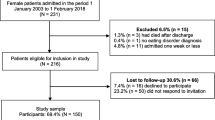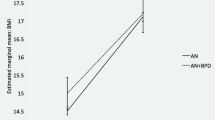Abstract
The aim of the study was to compare clinical presentations of eating disorders (ED) in midlife vs. younger inpatients. The sample consisted of 604 inpatients, 302 admitted to treatment at the age of 40 or older, and 302 admitted between ages 18–25, a more common ED age. Results suggested several unique features of midlife vs. younger ED inpatients: significantly more diagnoses of anorexia nervosa, both subtypes, and fewer diagnoses of bulimia nervosa; greater ED severity but fewer body image issues and less body image distortion; greater emotional and behavioral overcontrol and symptom denial; more bipolar and major depressive disorders, suicidality, and sexual abuse histories; a trend toward greater misuse of calming/sedating substances; and fewer maturation issues. The corresponding needs among midlife ED patients for specialized assessment and treatment interventions are considered.
Similar content being viewed by others
References
Garner D.M., Garfinkel P.E. (Eds.): Handbook of treatment for eating disorders (2nd ed.). New York, The Guilford Press, 1997.
Morris B.R.: Older women, too, struggle with a dangerous secret. The New York Times 2004, July 6. Retrieved on September 27, 2006, from http:// www.nytimes.com/2004/07/06/health/06anor.html
Maine M., Kelly J.: The body myth: Adult women and the pressure to be perfect. Hoboken, New Jersey, John Wiley & Sons, 2005.
Harris M., Cumella E. J.: Eating disorders across the life span. J. Psychosoc. Nurs. Ment. Health Serv., 44, 20–26, 2006.
Forman M., Davis W.N.: Characteristics of middleaged women in inpatient treatment for eating disorders. Eat. Disord., 13, 231–243, 2005.
Procopio C.A., Holm-Denoma J.M., Gordon K.H., Joiner T.E. Jr.: Two-three-year stability and interrelations of bulimotypic indicators and depressive and anxious symptoms in middle-aged women. Int. J. Eat. Disord., 39, 312–319, 2006.
Weiner K., Pryor T., Jones C.: Eating disorders at middle age: The desperate housewives effect. Paper presented at the symposium of the International Association of Eating Disorders, Chicago, IL, July 2006.
Kally Z., Cumella E.J.: 100 midlife women with eating disorders: A phenomenological analysis of etiology. J. Gen. Psychol., 135, 359–377, 2008.
Pickett J.P. (Ed.): The American heritage dictionary of the English language (4th ed.). Boston, Houghton Mifflin Company, 2000.
Berk L.E.: Development through the lifespan (4th ed.). Boston, Allyn & Bacon, 2006.
Fairburn C.G., Brownell K.D. (Eds.): Eating disorders and obesity: A comprehensive handbook (2nd ed.). New York, The Guilford Press, 2002.
Yager J., Devlin M.J., Halmi K.A., Herzog D.B., Mitchell J.E., Powers P., Zerbe K.J.: American Psychiatric Association practice guideline for the treat- ment of patients with eating disorders (3rd ed.), 2006. Retrieved on August 01, 2006, from http:// www.psych.org/psych_pract/treatg/pg/prac_guide.cfm
Eberly M.C.: Understanding self-injurious behavior in eating disorders. The Remuda Review, 4, 26–30, 2005.
The Child Abuse Prevention and Treatment Act, 42 U.S.C.§ 5101 et seq, 1996.
Butcher J.N., Dahlstrom W.G., Graham J.R., Tellegen A., Kaemmer B.: Minnesota Multiphasic Personality Inventory-2: manual for administration and scoring. Minneapolis, University of Minnesota Press, 1989.
Garner D.M.: ED Inventory-2: professional manual. Odessa, FL, Psychological Assessment Resources, Inc, 1991.
Beck A.T., Steer R.A., Brown G.K.: Beck Depression Inventory-Second Edition Manual. San Antonio, The Psychological Corporation, 1996.
Beck A.T., Steer R.A.: Beck Anxiety Inventory Manual. San Antonio, TX, The Psychological Corporation, 1993.
Polissar L., Diehr P.: Regression analysis in health services research: the use of dummy variables. Med. Care, 20, 959–966, 1982.
Cumella E.J., Wall A.D., Kerr-Almeida N.: MMPI-2 in the inpatient assessment of women with eating disorders. J. Pers. Assess., 75, 387–403, 2000.
McElroy S.L., Kotwal R., Keck P.E. Jr., Akiskal H.S.: Comorbidity of bipolar and eating disorders: distinct or related disorders with shared dysregulations? J. Affect. Disord., 86, 107–127, 2005.
Simpson S.G., al-Mufti R., Andersen A.E., DePaulo J.R. Jr.: Bipolar II affective disorder in eating disorder inpatients. J. Nerv. Ment. Dis., 180, 719–722, 1992.
Hollon S.D., Shelton R.C., Wisniewski S., Warden D., Biggs M.M., Friedman E.S., Husain M., Kupfer D.J., Nierenberg A.A., Petersen T.J., Shores-Wilson K., Rush A.J.: Presenting characteristics of depressed outpatients as a function of recurrence: Preliminary findings from the STAR*D clinical trial. J. Psychiatr. Res., 40, 59–69, 2006.
Garner D.M.: EDI-3, Eating Disorder Inventory −3. Lutz, FL, Psychological Assessment Resources, Inc., 2004.
Rayworth B.B., Wise L.A., Harlow B.L.: Childhood abuse and risk of eating disorders in women. Epidemiology, 15, 271–278, 2004.
Megargee E.I.: Using the MMPI-2 in criminal justice and correctional settings. Minneapolis, MN, University of Minnesota Press, 2006.
U.S. Census Bureau. 2000 Census of population and housing. Washington, DC, U.S. Government Printing Office, 2002.
Striegel-Moore R.H., Dohm F.A., Kraemer H.C., Taylor C.B., Daniels S., Crawford P.B., Schreiber G.B.: Eating disorders in white and black women. Am. J. Psychiatry, 160, 1326–1331, 2003.
Gundersen L.: Faith and healing. Ann. Intern. Med., 132, 169–172, 2000.
Fairburn C.G., Welch S.L., Norman P.A., O’Connor M.E., Doll H.A.: Bias and bulimia nervosa: how typical are clinic cases? Am. J. Psychiatry, 153, 386–391, 1996.
Portney L.G., Watkins M.P.: Foundations of clinical research: Applications to practice (2nd ed). Upper Saddle River, NJ, Pearson Education, 2000.
Perkins P.S., Klump K.L., Iacono W.G., McGue M.: Personality traits in women with anorexia nervosa: Evidence for a treatment-seeking bias? Int. J. Eat. Disord., 37, 32–37, 2004
Author information
Authors and Affiliations
Corresponding author
Rights and permissions
About this article
Cite this article
Cumella, E.J., Kally, Z. Comparison of middle-age and young women inpatients with eating disorders. Eat Weight Disord 13, 183–190 (2008). https://doi.org/10.1007/BF03327505
Received:
Accepted:
Published:
Issue Date:
DOI: https://doi.org/10.1007/BF03327505




